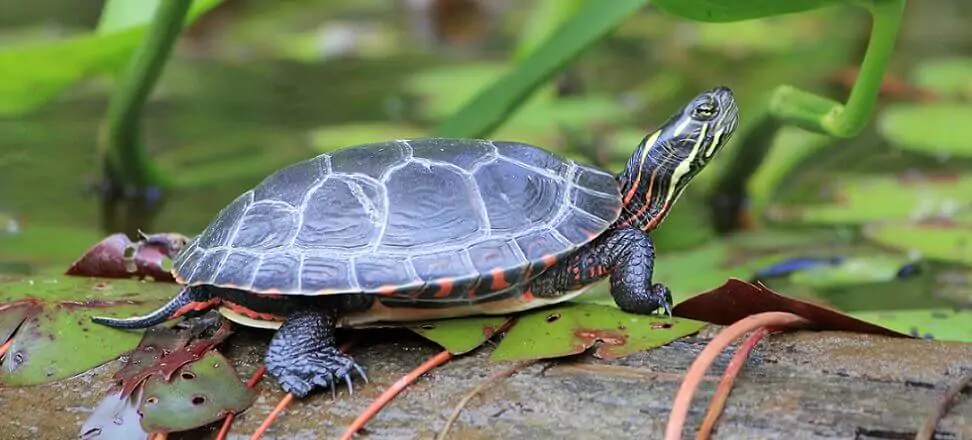Feedback
Alien species – invasions that inspire awe
Invasive alien species are considered one of the greatest threats to global biodiversity. However, this is not a threat that came from outer space. Alien species, if they are indeed alien to nature in a particular region, are certainly not so to humans, who bear full responsibility for their appearance in a new place. The presence of these species, after all, is due to their transfer by humans outside their natural range, whether this was intentional or not.
Foreign species well known to us
The most alien to nature are domesticated species, that is, species whose evolutionary process has been influenced by humans, adapting them to their needs. Examples include the most commonly kept pets, namely dogs and cats, as well as livestock, such as pigs and cattle. None of them occur naturally in nature, as they do not inherit the ranges of their ancestors. This means that man is particularly responsible for them. The same is true of many exotic species that humans take into their care to keep as companion, ornamental or breeding animals. A whole range of reptiles, amphibians, fish and aquatic invertebrates can be distinguished.
Alien species are, of course, also found among plants. One can venture to say that most of the plants known to the average person are just foreign species. Just look at gardens, parks, fields or orchards, where not only a variety of domesticated plants are grown, but also ornamental exotics. There is nothing wrong with that, as long as one takes responsibility for one’s actions.
Where do alien species come from?
Unfortunately, in many cases a person runs away from this responsibility, abandoning his charges. The same is true of plants, which are not only sometimes dumped into the natural environment, but also “escape” themselves from crops and home gardens. Of course, the ways of introducing alien species stand out a lot more, but at the root of most of them is simple carelessness and lack of responsibility for the consequences of one’s own actions.
It is difficult to blame alien species observed in the environment for trying to find their way in an unfamiliar world or simply surviving in it, but sometimes they pose a threat (e.g., by competing with native species) and thus become invasive. Therefore, it makes sense to use terms such as alien species or invasive alien species as they are intended. Each of these terms clearly indicates human responsibility, both for their presence in a given ecosystem and for their possible invasiveness. After all, it only applies to alien species, that is, introduced by humans.
Among the most common causes of pet abandonment is buying under the influence of the moment, that is, without substantive preparation, and therefore without knowing how to care for the species and what its needs are. Many animal caretakers have no idea what species they are breeding. One reason is that they are offered under inaccurate trade names. As an example, here is the name “aquatic turtle,” under which at least several different species of these animals can be hidden. However, it is worth noting that these names are a kind of response to customer needs, indicating that the species name and knowledge of the animal’s needs is simply irrelevant.
The pet market is struggling with a number of problems. There is a reason why in some stores you can still buy species that should not be there. These will include not only animals on lists of invasive alien species posing a threat to Poland and the Union (e.g., Louisiana crayfish), but also genetically modified fish (e.g., danio fluo) and even fish artificially colored by subcutaneous injection. The presence of such species in stores is the result of loopholes, as well as limited control and still meager public interest. With “top-down permission,” it is difficult to make changes when the availability of such animals continues to attract numerous customers uninterested in the biology and needs of their future charges.
“Freedom” of alien species
It is believed that only a fraction of the abandoned animals associated with aquatic environments end up in the environment. Most, due to their small size, are flushed alive in the toilet. In both cases, the “caretakers” try to justify themselves by calling the abandonments “letting loose” or “giving a second life.” The latter is often an attempt to get away with treating animals with health problems. Of course, it is not the animal that gains freedom, which should be understood here as providing proper care and living conditions, but the caregiver trying to free himself from his duty. Without seeing the death of their charge, they do not feel responsible for it.
Most animals abandoned in the environment die in the first hours and days, mainly from hypothermia and injuries. Some exotic species can survive for up to several months if abandoned during the summer. Only a few manage to survive the winter, and perhaps reproduce. Under current regulations, they would have to be treated as stray animals, and thus should be trapped. Local governments decide whether animals observed in the environment actually have no home. If it is suspected that the animal in question has never had a keeper, trapping is not undertaken.
The runaway success of local governments in carrying out their tasks is aided by the approach of local communities. In many cases, abandoned animals, especially exotic ones, are turned into local attractions, which only contributes to further abandonments. A classic example would be ornamental turtles. Those bought, as a rule, are the size of a five-dollar coin, and quickly reach sizes that surpass not so much the terrarium as the expectations of the unprepared keeper.
Of course, this does not apply to all species, but only to those that are not considered a potential threat by the average person. The situation is different, for example, in the case of snakes or piranha fish, whose presence in the environment is eagerly publicized by the media. For example, in every province in Poland there has been at least one article about some angler having caught a piranha paku. A “wow, what else can be caught in Polish rivers?” effect is created. Much less attention is paid to the animal itself, to the fact that it was abandoned.
The same can be written about dogs and cats. Only the latter have the acquiescence of at least some of the public to run freely without supervision. The so-called outdoor cats here are one example of a caregiver running away from his duties, yet he is responsible for his charges, including their safety and any danger posed to nature. The problem is so widespread that BirdLife’s latest reports, based on data from the International Union for Conservation of Nature IUCN, say the cat is an invasive alien species that is dangerous to endangered bird species. Next on the list is the dog. Only a few positions further down the list is the American vison (American mink) or raccoon. It should be emphasized here that this is not and never has been the fault of these animals, but of their irresponsible caretakers.

Foreign species a tourist attraction
Currently, several cases worthy of attention can be observed in Poland. The first is the still sparse population of collar alexandrette. This “ornithological sensation” is covered by the media every year, and the public marvels at these parrots, which have been treated as a local attraction instead of being trapped. The authorities may not be reacting because the failure to catch the first parrots, which could still be considered homeless under the Animal Welfare Act, has contributed to their proliferation, as well as the possible release of more individuals. Thus, as non-domesticated animals, but living in conditions independent of humans, they began to meet the statutory definition of wild animals, and these are treated as a national asset and should be provided with a free existence.
At a far more advanced stage are already the “local mascots” of several cities in different regions of the country, namely nutria. By their example, one can observe the subsequent fate of such animals, which, due to their uncontrolled population growth and posing a threat to biodiversity and related ecosystem services (e.g., destruction of riverbanks), have been placed on the list of invasive alien species – in this case – posing a threat to the Union. It leads to a situation where nutrias can count on no other solution than trapping and putting to sleep. And yet this could have been remedied before the population grew.
A local asylum could be created and possible media exposure could be used to promote a solution that respects the welfare of these animals and the responsibility for them. Unfortunately, while there is no shortage of voices opposing the elimination of nutria, no one is making an attempt to create an asylum for them, although the problem has been known for years.
From this it is not far to copy such sites in other regions, with the associated abandonment of more animals, future invasive alien species. All this is happening despite the conflicts that are occurring, which, because of the failure to take top-down action, are being resolved through self-judgment: poisoning, maiming and killing. However, even this does not discourage owners from “unleashing” their pets.
Destructive human activity
However, the escape from responsibility does not end there. When the situation is out of control, and at the same time the need for action is already apparent, as the problem has begun to affect people, the military metaphor emerges. Previously awe-inspiring animals are beginning to be called pests. Although they are not a party to the conflict, they are called “invaders.” These terms, as opposed to alien species or invasive alien species, shift the blame from humans to the animal, because that is what is meant by calling them a pest or enemy. Meanwhile, it is man who is responsible for the presence of alien species in the environment and it is he who, through these species, poses a threat to biodiversity.
The loosely tossed “the most invasive is man” is meant to discourage countermeasures, consisting of, among other things. on the harvesting of non-native species from the environment, and at the same time indicates that the person throwing this slogan is not very familiar with the subject matter, using the terms incorrectly. Juxtaposing species whose choice was never to find themselves in an unfamiliar world, no matter how often called their “new home,” with a human who can choose for them is just plain wrong. Man is unquestionably the most destructive species in the world, but certainly not alien or invasive, as invasiveness only applies to alien species, often abandoned.
Taking an animal into our care, we are responsible for it. However, despite the best intentions, there are times when it is not possible to continue caring for him. In such a situation, we are obliged to find our charge a new guardian and the best living conditions. Abandonment in the environment is never a good solution.
In the article, I used, among other things. From the works:
[1] Bellard C., Cassey P., Blackburn T. M. 2016. Alien species as a driver of recent extinctions. Biology letters, 12: p.20150623.
[2] Bláha M., Weiperth A., Patoka J., Szajbert B., Balogh E. R., Staszny Á., Ferincz Á., Lente V., Maciaszek R., Kouba A. 2022. The pet trade as a source of non-native decapods: the case of crayfish and shrimps in a thermal waterbody in Hungary. Environmental Monitoring and Assessment 194, 795.
[3] Diagne C., Leroy B., Vaissière A. C., Gozlan R. E., Roiz D., Jarić I., Salles J. M., Bradshaw C. J., Courchamp F., 2021. High and rising economic costs of biological invasions worldwide. Nature, 592: 571-576.
[4] Harrower C. A., Scalera R., Pagad S., Schonrogge K., Roy H. E. 2018. Guidance for interpretation of CBD categories on introduction pathways.
[5] Lees A. C., Haskell L., Allinson T., Bezeng S. B., Burfield I. J., Renjifo L. M., Rosenberg K. V., Viswanathan A., Butchart S. H. 2022. State of the world’s birds. Annual Review of Environment and Resources, 47, 231-260.
[6] General Directorate for Environmental Protection website dedicated to invasive alien species: http://projekty.gdos.gov.pl/igo-o-projekcie
[7] Site of the Database of Alien Species in Poland maintained by the Institute of Nature Conservation of the Polish Academy of Sciences in Krakow: https://www.iop.krakow.pl/ias
[8] Alien Hunter Project website: https://lowcaobcych.pl
[9] Law of August 21, 1997. on the protection of animals
[10] Law of April 16, 2004. on nature protection
[11] Law of August 11, 2021. about alien species

 Polski
Polski







